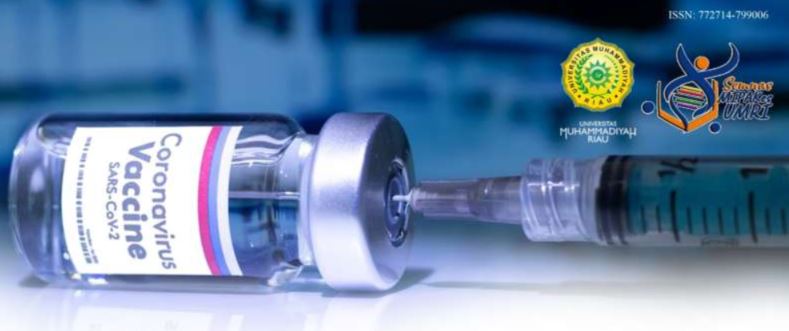HUBUNGAN ANTARA KEBERADAAN TIKUS DAN FAKTOR LINGKUNGAN ABIOTIK TERHADAP INFEKSI LEPTOSPIRA DI TIKUS (STUDI CROSS SECTIONAL DI KABUPATEN KARANGANYAR, PROVINSI JAWA TENGAH)
DOI:
 https://doi.org/10.37859/sainstekes.v2i0.2897
https://doi.org/10.37859/sainstekes.v2i0.2897
Abstrak
Data Dinas Kesehatan Kabupaten Karanganyar mencatat tujuh kasus leptospirosis dengan lima kematian pada 2020 sejak Januari hingga Februari. Desa Gawanan adalah salah satu desa yang ditemukan kasus dengan satu kasus kematian. Tujuan dari penelitian ini adalah untuk melihat keberhasilan penangkapan tikus dan untuk menentukan hubungan antara keberadaan tikus dan faktor lingkungan abiotik terhadap infeksi Leptospira. Desain studi adalah deskriptif analitik dengan pendekatan cross sectional. Penelitian dilakukan di Desa Gawanan, Kecamatan Colomadu, pada Februari 2020. Penangkapan tikus dilakukan selama dua hari. Seratus perangkap hidup dipasang selama dua hari berturut-turut. Leptospira pada ginjal tikus dideteksi dengan metode Polymerase Chain Reaction (PCR). Variabel tikus yang tertangkap adalah spesies dan jenis kelaminnya. Faktor lingkungan abiotik yang diukur adalah pH air, suhu air, suhu udara, dan kelembaban udara. Data dianalisis menggunakan uji bivariat. Jumlah tikus yang tertangkap sebanyak 31 ekor. Jumlah keberhasilan penangkapan tikus adalah 15,5%. Proporsi Rattus tanezumi adalah 67,7% (4,8% positif infeksi Leptospira), dan Rattus norvegicus adalah 32,3% (10% positif infeksi Leptospira). Proporsi tikus jantan adalah 51,6% daripada tikus betina. Statistik menunjukkan bahwa keberadaan tikus dan faktor lingkungan abiotik tidak terkait secara signifikan pada infeksi Leptospira. Keberhasilan penagkapan tikus yang tinggi dapat menjadi risiko infeksi Leptospira.
Unduhan
Referensi
Allan, K. J. et al. (2015) ‘Epidemiology of leptospirosis in Africa: A systematic review of a neglected zoonosis and a paradigm for “one health” in Africa’, PLoS Neglected Tropical Diseases, 9(9), pp. 1–25. doi: 10.1371/journal.pntd.0003899.
Arumsari, W., Sutiningsih, D. and Hestiningsih, R. (2012) ‘Analisis Faktor Lingkungan Abiotik yang Mempengaruhi Keberadaan Leptospirosis pada Tikus di Kelurahan Sambiroto, Kecamatan Tembalang, Kota Semarang’, Jurnal Kesehatan Masyarakat, 1(2), pp. 514–524.
Balai Besar Litbang Vektor dan Reservoir Penyakit (2015) Pedoman Pengumpulan Data Reservoir (Tikus) di Lapangan Riset Khusus Vektor dan Reservoir Penyakit. Available at: http://www.b2p2vrp.litbang.kemkes.go.id/publikasi/download/61.
Barragan, V. et al. (2017) ‘Critical knowledge gaps in our understanding of environmental cycling and transmission of Leptospira spp.’, Applied and Environmental Microbiology, 83(19), pp. 1–10. doi: 10.1128/AEM.01190-17.
Benacer, D. et al. (2016) ‘Determination of Leptospira borgpetersenii serovar Javanica and Leptospira interrogans serovar Bataviae as the persistent Leptospira serovars circulating in the urban rat populations in Peninsular Malaysia’, Parasites and Vectors, 9(1), pp. 1–11. doi: 10.1186/s13071-016-1400-1.
Bierque, E. et al. (2020) ‘A systematic review of Leptospira in water and soil environments’, PLoS ONE, 15(1), pp. 1–22. doi: 10.1371/journal.pone.0227055.
Brockmann, S. O. et al. (2016) ‘Risk factors for human Leptospira seropositivity in South Germany’, SpringerPlus, 5(1), pp. 2–8. doi: 10.1186/s40064-016-3483-8.
Costa, F. et al. (2015) ‘Global Morbidity and Mortality of Leptospirosis : A Systematic Review’, PLoS Neglected Tropical Diseasess, 17(September), pp. 1–19. doi: 10.1371/journal.pntd.0003898.
Desi Rini Astuti (2013) ‘Keefektifan Rodentisida Racun Kronis Generasi II Terhadap Keberhasilan Penangkapan Tikus’, Jurnal Kesehatan Masyarakat, 8(2), pp. 183–189.
Feng, A. Y. T. and Himsworth, C. G. (2014) ‘The secret life of the city rat: A review of the ecology of urban Norway and black rats (Rattus norvegicus and Rattus rattus)’, Urban Ecosystems, 17(1), pp. 149–162. doi: 10.1007/s11252-013-0305-4.
Kemenkes RI (2017) ‘Peraturan Menteri Kesehatan RI No. 50 tahun 2017 tentang Standar Baku Mutu Kesehatan dan Persyaratan Kesehatan Untuk Vektor dan Binatang Pembawa Penyakit serta Pengendaliannya.’, Berita Negara Republik Indonesia, pp. 1–83. doi: DOI:
Lau, C. L. et al. (2016) ‘Human Leptospirosis Infection in Fiji: An Eco-epidemiological Approach to Identifying Risk Factors and Environmental Drivers for Transmission’, PLoS Neglected Tropical Diseases, 10(1), pp. 1–25. doi: 10.1371/journal.pntd.0004405.
Loan, H. K. et al. (2015) ‘How important are rats as vectors of leptospirosis in the mekong delta of vietnam?’, Vector-Borne and Zoonotic Diseases, 15(1), pp. 56–64. doi: 10.1089/vbz.2014.1613.
Maniiah, G., Raharjo, M. and Astorina, N. (2016) ‘Faktor lingkungan yang berhubungan dengan kejadian leptospirosis di kota semarang’, Jurnal Kesehatan Masyarakat (e-Journal), 4(3), pp. 792–798.
Mendoza, M. V. and Rivera, W. L. (2019) ‘Identification of Leptospira spp. from environmental sources in areas with high human leptospirosis incidence in the Philippines’, Pathogens and Global Health, 113(3), pp. 109–116. doi: 10.1080/20477724.2019.1607460.
Mwachui, M. A. et al. (2015) ‘Environmental and Behavioural Determinants of Leptospirosis Transmission: A Systematic Review’, PLoS Neglected Tropical Diseases, September(17), pp. 1–15. doi: 10.1371/journal.pntd.0003843.
Ristiyanto et al. (2015) ‘Prevalensi tikus terinfeksi Leptospira interogans di Kota Semarang, Jawa Tengah’, Vektora, 7(2), pp. 85–92.
Samekto, M. et al. (2019) ‘Faktor-Faktor yang Berpengaruh terhadap Kejadian Leptospirosis (Studi Kasus Kontrol di Kabupaten Pati)’, Jurnal Epidemiologi Kesehatan Komunitas, 4(1), pp. 27–34. doi: 10.14710/jekk.v4i1.4427.
Schneider, A. G. et al. (2018) ‘Quantification of pathogenic Leptospira in the soils of a Brazilian urban slum’, PLoS Neglected Tropical Diseases, 12(4), pp. 1–15. doi: 10.1371/journal.pntd.0006415.
Setiyani, E., Martini, M. and Saraswati, L. D. (2018) ‘The Presence of Rat and House Sanitation Associated with Leptospira sp. Bacterial Infection in Rats (A Cross Sectional Study in Semarang, Central Java Province, Indonesia)’, in E3S Web of Conferences, pp. 1–4. doi: 10.1051/e3sconf/20183106008.
Sumanta, H. et al. (2015) ‘Spatial Analysis of Leptospira in Rats, Water and Soil in Bantul District Yogyakarta Indonesia’, Open Journal of Epidemiology, 5(1), pp. 22–31.
Tangkanakul, W. et al. (2000) ‘Risk factors associated with leptospirosis in Northeastern Thailand, 1998’, American Journal of Tropical Medicine and Hygiene, 63(3–4), pp. 204–208. doi: 10.4269/ajtmh.2000.63.204.
Thibeaux, R. et al. (2017) ‘Seeking the environmental source of Leptospirosis reveals durable bacterial viability in river soils’, PLoS Neglected Tropical Diseases, 11(2), pp. 1–14. doi: 10.1371/journal.pntd.0005414.
Tung, K. C. et al. (2013) ‘Study of the endoparasitic fauna of commensal rats and shrews caught in traditional wet markets in Taichung City, Taiwan’, Journal of Microbiology, Immunology and Infection, 46(2), pp. 85–88. doi: 10.1016/j.jmii.2012.01.012.
Widiastuti, D. et al. (2016) ‘Identification of Pathogenic Leptospira in Rat and Shrew Populations Using rpoB Gene and Its Spatial Distribution in Boyolali District’, Kesmas: National Public Health Journal, 11(1), pp. 32–38. doi: 10.21109/kesmas.v11i1.798.








